L.A. needs clean energy. Hydrogen could be the answer — or gas industry greenwashing
Southern California runs on petroleum, with a long history of oil drilling and a landscape dominated by cars and freeways.
But Angelenos are also deeply dependent on another dirty fuel.
Every day, millions of homes and thousands of businesses receive more than 15 billion gallons of natural gas, on average, from the nation’s largest gas utility, Southern California Gas Co. Families use the planet-warming fuel to stay warm in the winter and cook dinner on gas stoves. Power plants burn it to generate electricity that powers air conditioners on hot summer days.
Most of the gas flows in from other states via pipeline. Some is tucked away at local storage fields, including Aliso Canyon, site of a record-shattering methane leak. Some of it never reaches the Los Angeles Basin at all, leaking from wellheads or pipelines and rising into the atmosphere, where it traps heat even more powerfully than the carbon dioxide emitted when it’s burned.
Scientists say there’s an urgent need to phase out fossil fuels and end the unprecedented global heating that is driving deadlier and more destructive heat waves, wildfires, droughts and floods. So how will Southern California solve its natural gas problem?
SoCalGas says it has at least a partial answer: hydrogen.
The Sempra Energy subsidiary proposed last month to build “the nation’s largest green hydrogen energy infrastructure system.” Known as Angeles Link, it could include hundreds of miles of pipelines to bring the clean-burning fuel to power plants, factories and the ports of L.A. and Long Beach. SoCalGas customers would bear the cost, which could amount to billions of dollars.
“It allows California to dramatically advance its climate and environmental goals,” SoCalGas President Maryam Brown said in an interview. “It creates a cornerstone for the California green hydrogen economy, and the hydrogen economy in general.”
Gov. Gavin Newsom seems to agree. Asked about Angeles Link at a news conference, he called it “a step in the right direction.”
But is hydrogen a crucial clean energy solution, or a greenwashing boondoggle that would prop up the fossil fuel industry?
Newsletter
Your guide to our clean energy future
Get our Boiling Point newsletter for the latest on the power sector, water wars and more — and what they mean for California.
You may occasionally receive promotional content from the Los Angeles Times.
It’s a question driving fierce debate among environmentalists, elected officials and labor unions — in Southern California and around the world, as companies plan hundreds of billions of dollars in investments that could launch the hydrogen era.
Los Angeles officials hope to play a leading role — but only if they determine hydrogen will do more good than harm.
“Anybody who says green hydrogen is going to work for sure doesn’t yet know what they’re talking about,” Mayor Eric Garcetti said in an interview. “Anybody who says green hydrogen won’t work for sure doesn’t know what they’re talking about.”
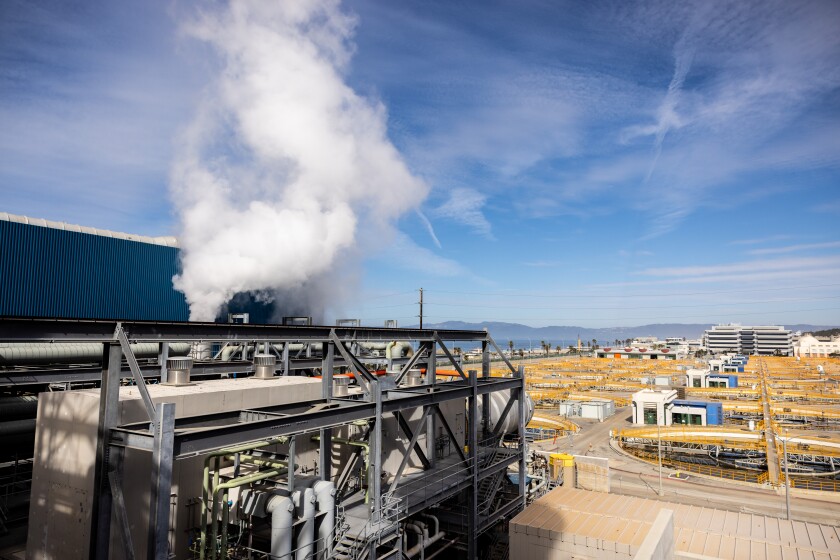
Steam rises from Unit 5 at Scattergood Generating Station on the coast near El Segundo, with the Hyperion wastewater treatment plant in the background.
(Jay L. Clendenin / Los Angeles Times)
A clean fuel with baggage
Hydrogen, the world’s lightest molecule, has long been used in oil refining and fertilizer production. But there’s been a surge of interest the last few years, with the Los Angeles Department of Water and Power emerging as one of the fuel’s biggest boosters.
DWP has begun the process of converting the city’s largest electricity source — Intermountain Power Plant outside Delta, Utah — from coal to hydrogen. If the first-of-its-kind project goes as planned, DWP hopes to retrofit four gas-fired power plants in the L.A. Basin as well, including Valley Generating Station in Sun Valley and Scattergood Generating Station near El Segundo.
The hydrogen pipelines proposed by SoCalGas would supply those L.A.-area plants, allowing DWP to generate electricity during the rare moments when solar panels, wind turbines and batteries won’t be enough to power the city. It’s the kind of reliable energy resource Los Angeles will need to achieve its goal of 100% clean electricity by 2035, DWP General Manager Marty Adams said.
“Green hydrogen is really the way, unless something comes up that isn’t invented yet,” he said.
The fuel costs far more than fossil gas, but it’s expected to get cheaper as technology scales up. SoCalGas and DWP are working to slash green hydrogen costs from $5 per kilogram to $1.50 by 2030, and the Biden administration has set an even lower target.
Environmental justice activists are skeptical.
They want L.A. officials to follow through on their promise to shut down gas plants — especially Valley Generating Station, which is in a heavily polluted, largely Latino community. Although hydrogen combustion doesn’t produce carbon dioxide, it does generate lung-damaging nitrogen oxide pollution, or NOx — much more than fossil gas, at least using current technology.
“Every day we have some other false solution coming at us,” said Martha Dina Argüello, executive director of Physicians for Social Responsibility-Los Angeles. “The environmental justice problems that we live with are going to continue and get worse.”
Support our journalism
Your support helps us deliver the news that matters most. Subscribe to the Los Angeles Times.
Activists do see a role for hydrogen in fighting climate change — but mostly in “hard to electrify” industries where switching from dirty fuels to electric power is expected to be prohibitively expensive, such as shipping, aviation, steelmaking and potentially long-haul trucking. Their preferred technology is hydrogen fuel cells, which produce no pollution and can power heavy-duty trucks.
Outside those industries, though, activists worry about companies using hydrogen as an excuse to keep peddling oil and gas.
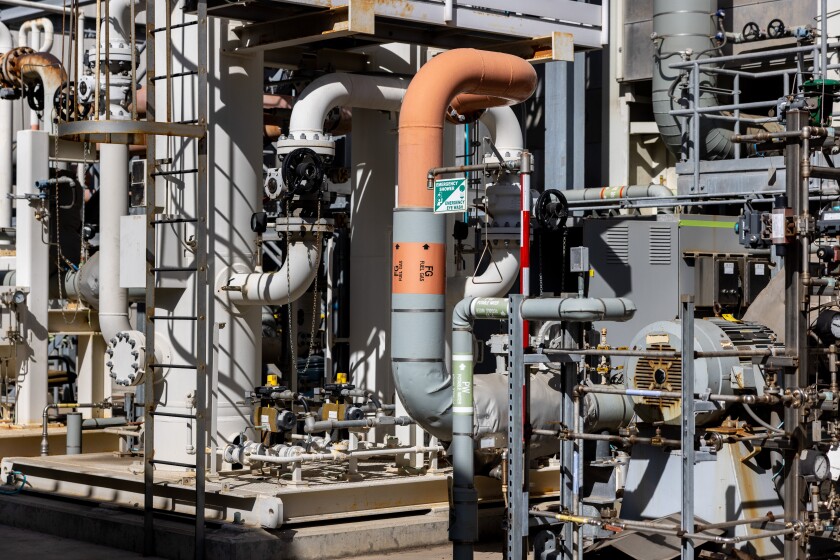
Pipes carry natural gas to Unit 4 at DWP’s Scattergood Generating Station, which is part of a “combined cycle” system. Unit 4 combusts natural gas to generate electricity, and then Unit 5 uses the waste heat to produce additional power.
(Jay L. Clendenin / Los Angeles Times)
SoCalGas, for instance, estimates Angeles Link could help to displace 25% of the gas it delivers today — some, but far from all. And although none of that hydrogen would be used for heating and cooking, SoCalGas has separate initiatives to test out “blending” — mixing small amounts of hydrogen into the pipelines that serve homes, reducing but not eliminating heat-trapping emissions.
That’s a nonstarter for climate advocates. They point to research finding that replacing gas appliances with electric heat pumps and induction stoves is a far more effective climate strategy, and can also reduce indoor air pollution from cooking with gas.
But electrification threatens the gas utility business model, which is why SoCalGas and other companies have fought government policies requiring new homes to be all-electric. A similar battle played out at the ports of L.A. and Long Beach, where an industry trade group whose members include SoCalGas lobbied officials to prioritize biofuels over electric trucks to clean up air pollution.
Some environmentalists worry that hydrogen will become the gas industry’s latest excuse to block electrification.
“I don’t have a lot of trust that this is not another way of getting the camel’s nose under the tent,” Argüello said.
Garcetti has a similar concern. He’s skeptical about using hydrogen for home heating and cooking, saying the city should be “careful to guard against people throwing in a little bit of supposed green hydrogen to greenwash gases that are destroying the planet.”
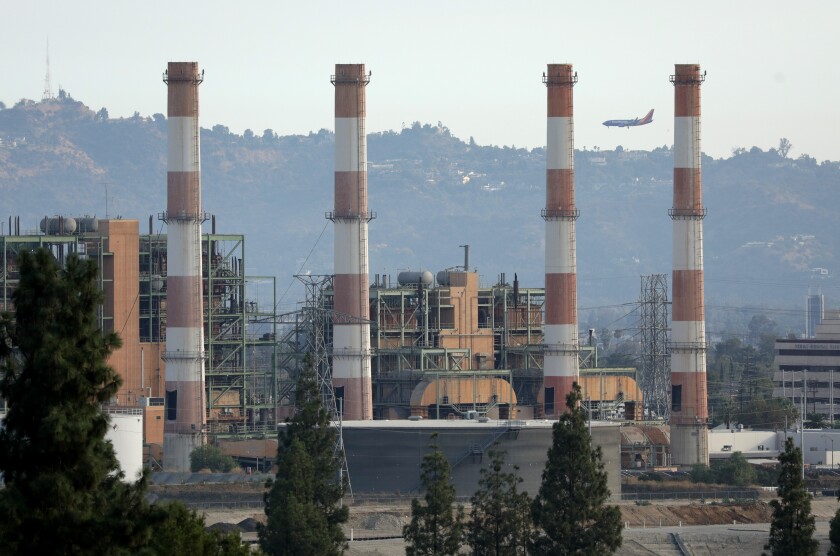
DWP’s gas-fired Valley Generating Station in Sun Valley. Community activists are campaigning to close the plant because of health and environmental concerns.
(Myung J. Chun / Los Angeles Times)
But as the hydrogen economy grows, Garcetti is hopeful the fuel can help combat the climate crisis and reduce air pollution.
“We want to be the coauthors of this new chapter. We’re not passive bystanders,” he said.
A struggle at City Hall
A few weeks after SoCalGas rolled out its Angeles Link initiative, a related battle roiled L.A.’s halls of power.
The bipartisan infrastructure bill approved by Congress in November included $9.5 billion to drive down hydrogen costs and establish regional hydrogen production hubs — money the Biden administration is now making plans to distribute. Several City Council members introduced a motion this month calling on DWP and the Port of L.A. to apply for some of those funds.
Even before the motion was introduced, it was the subject of furious behind-the-scenes lobbying.
Groups including the California Environmental Justice Alliance and the Sierra Club asked council members to allow only “green” hydrogen, produced from water and clean energy sources such as solar or wind. (Most of the hydrogen in use today is produced from fossil fuels in a highly polluting process.) Environmentalists also urged the city to “make no investments related to hydrogen combustion” at power plants without first addressing several concerns, including potentially high levels of local air pollution.
“Trading our climate goals for our health goals does not make sense,” the Sierra Club’s Monica Embrey said.
The final text of the City Council motion incorporated those points. But some clean energy activists still weren’t satisfied.
Alex Nagy, California director of Food & Water Watch, said she’s “very uncomfortable with L.A. applying to become a hydrogen hub.” She believes DWP hasn’t exhausted other options to phase out fossil gas, including local solar installations, energy efficiency and “demand response” programs that pay homes and businesses to use less electricity when the power grid is stressed.
Meanwhile, SoCalGas stands to make a huge guaranteed profit if state officials approve its Angeles Link hydrogen project.
“It’s this total boon for them,” Nagy said.
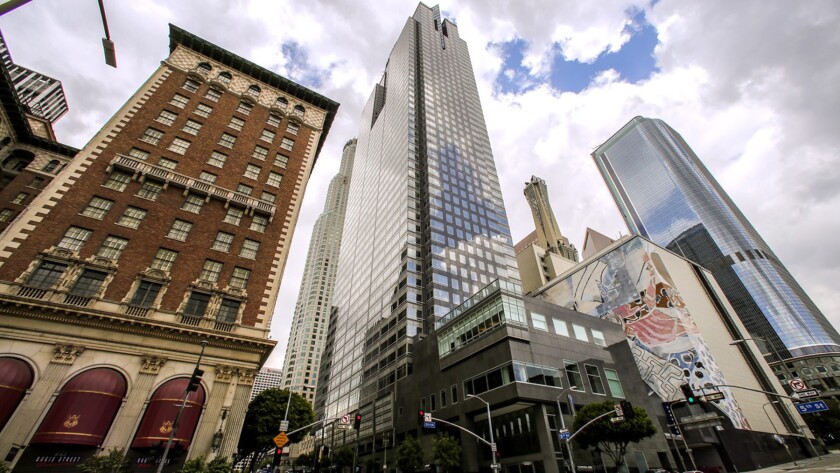
SoCalGas’ headquarters are in the Gas Company Tower, center, in downtown Los Angeles.
(Irfan Khan / Los Angeles Times)
Shortly after the L.A. hydrogen hub motion was introduced, Council Member John Lee rolled out a separate resolution calling for the city to support the gas company’s hydrogen project. Lee was quoted in a SoCalGas news release as saying Angeles Link “will help us get one step closer to achieving the city’s goal of 100% clean energy by 2035 without compromising reliability and hurting jobs.”
Jobs have been a political flashpoint in battles over the future of natural gas. When San Luis Obispo officials planned to vote on an all-electric buildings policy early in the pandemic, for instance, Eric Hofmann — president of a labor union representing thousands of SoCalGas employees — threatened a “no social distancing” protest that he said would “potentially [add] to this pandemic.”
The promise of hydrogen infrastructure could ease those battles, offering a lifeline both to SoCalGas employees and to plumbers and pipefitters represented by the politically powerful Los Angeles/Orange County Building and Construction Trades Council.
Still, green hydrogen is no panacea. In addition to local air-pollution concerns, producing the fuel requires lots of water — a resource in ever-shorter supply as the Western U.S. endures its worst drought in at least 1,200 years, fueled by global warming.
The nonprofit Environmental Defense Fund, meanwhile, just released a research paper — currently going through peer review — finding hydrogen can actually worsen climate change in the short term if too much of it leaks from pipelines before it’s burned.
Asked about that research, SoCalGas spokesperson Chris Gilbride said leaks shouldn’t be a major issue for Angeles Link.
“This is a new pipeline designed for hydrogen, so we would not anticipate those problems,” he said.
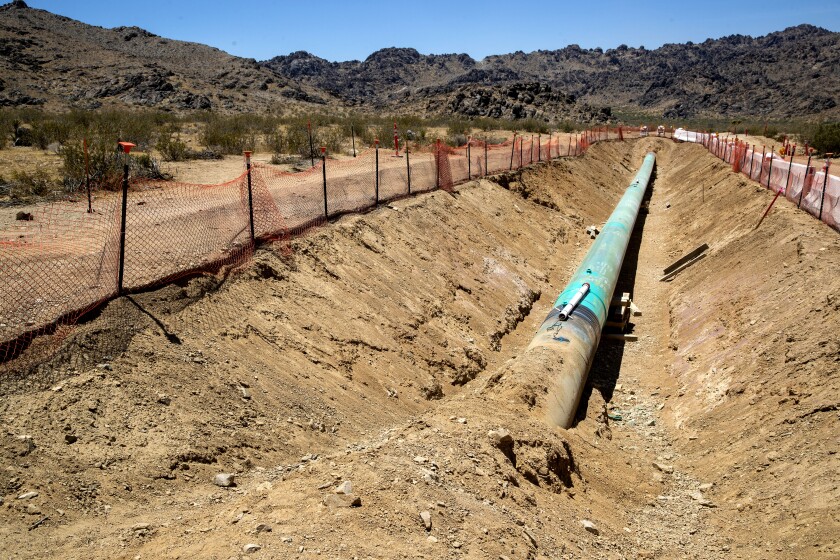
A SoCalGas pipeline known as Line 235, which brings natural gas through the desert toward the L.A. Basin, undergoes repairs after an October 2017 explosion.
(Brian van der Brug / Los Angeles Times)
SoCalGas makes its play
Gas company executives say Angeles Link would transport only green hydrogen, not fossil gas. In addition to local power plants, the pipelines would supply the “hard to electrify” sectors where climate activists generally see hydrogen as a good idea.
But SoCalGas has otherwise offered few details on what Angeles Link might look like. A fact sheet on the utility’s website initially suggested the project could include 200 to 750 miles of new pipeline, although it was later edited to remove those numbers.
Instead, SoCalGas told the California Public Utilities Commission it would like to spend an estimated $118 million in customer money to begin studying and designing hydrogen infrastructure to serve the L.A. Basin. Those funds would cover the project’s first two phases, with a third phase to follow that could cost “several hundreds of millions of dollars” more — all before construction begins.
It’s a lot of money — but for an infrastructure project of this size, “the order of magnitude makes sense,” said Michael Colvin, a former Public Utilities Commission official who now leads the California energy program at the Environmental Defense Fund.
Colvin said he’s intrigued by Angeles Link, calling it “the first step, in terms of new dedicated infrastructure, that’s been proposed like this anywhere in the country.” He said his group will scrutinize the proposal as it’s considered by the utilities commission.
“This is the largest gas company in the country trying to figure out how they go about decarbonizing their system,” he said.
SoCalGas isn’t yet asking for permission to charge customers for hydrogen-related costs — only for approval to open a “memo account” to track spending, which would make it easier for the company to recover those funds from customers later.
But Angeles Link will never get built unless the Public Utilities Commission eventually lets SoCalGas bill ratepayers for the costs.
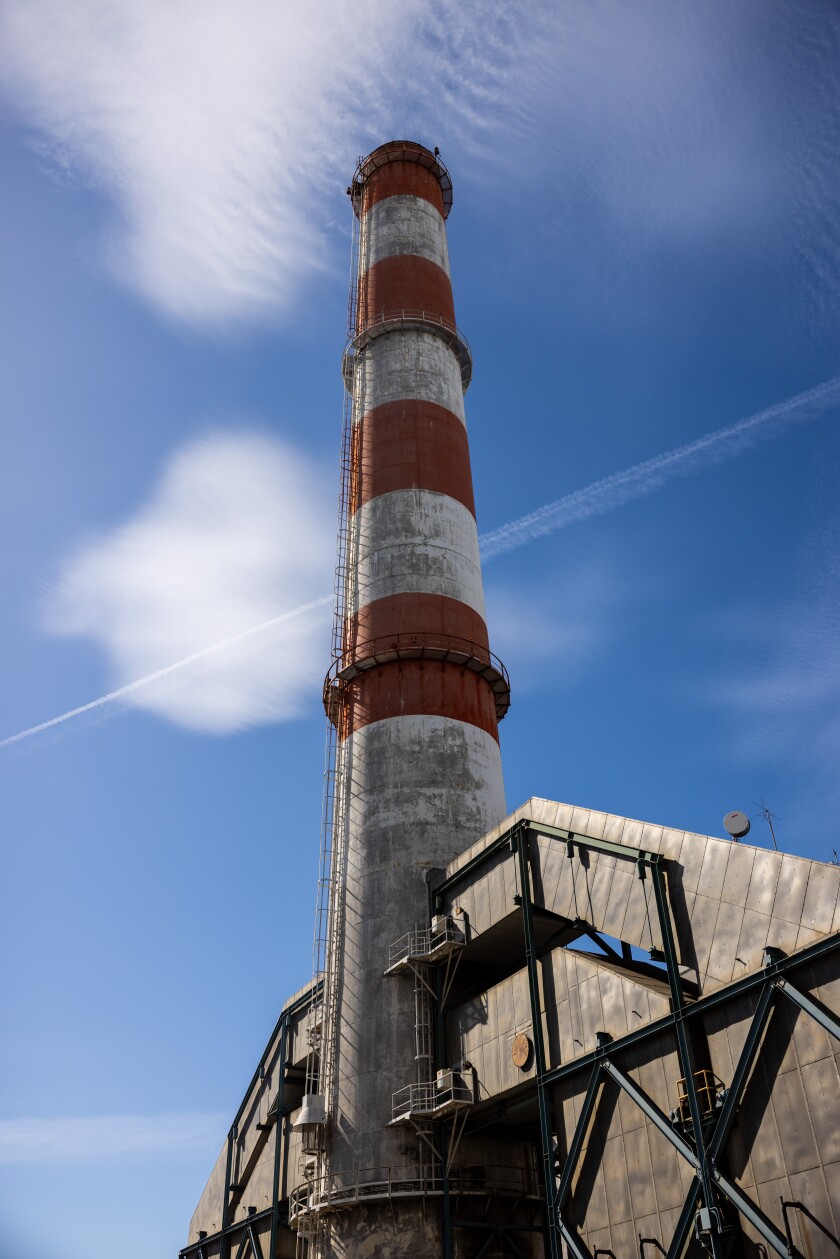
A smokestack at Scattergood Generating Station near El Segundo.
(Jay L. Clendenin / Los Angeles Times)
The project’s fate could hinge on whether the utility can persuade state officials that hydrogen would not only help tackle the climate crisis, but also limit nitrogen oxides and other air pollutants in low-income communities of color. The gas company acknowledges the environmental justice concerns in its Angeles Link application, saying it “does not support relaxation of current NOx emissions standards, and stands ready to provide any technical assistance” on research that could lead to lower emissions.
At the same time, the gas company notes that hydrogen could dramatically reduce hazardous air pollution from heavy-duty trucks, estimating that Angeles Link could deliver enough clean-burning fuel to displace 3 million gallons of diesel each day.
DWP officials have made a similar case, saying hydrogen-fueled power plants could play a role in lessening the region’s infamous smog by ensuring the reliable power grid that’s needed to fuel electric vehicles and ditch cars and trucks that run on oil.
What’s more, those hydrogen plants would serve as an important but rarely used backup on a grid dominated by solar and wind power, meaning they would fire up far less often than today’s gas plants, said Jason Rondou, DWP’s director of resource planning. Turbine manufacturers, meanwhile, are working on technology that would further limit pollution from hydrogen combustion.
“We don’t want to minimize the importance of reducing NOx. But we do want to characterize the contribution as very, very low,” Rondou said. “What moves the needle on local air-quality improvements is the decarbonization of the transportation sector.”
And therein lies the rub for climate activists: They see hydrogen as a potentially useful tool to slash emissions, in L.A. and globally. But they don’t necessarily trust the fossil fuel industry to wield that tool, given its long history of climate denial and obstruction.
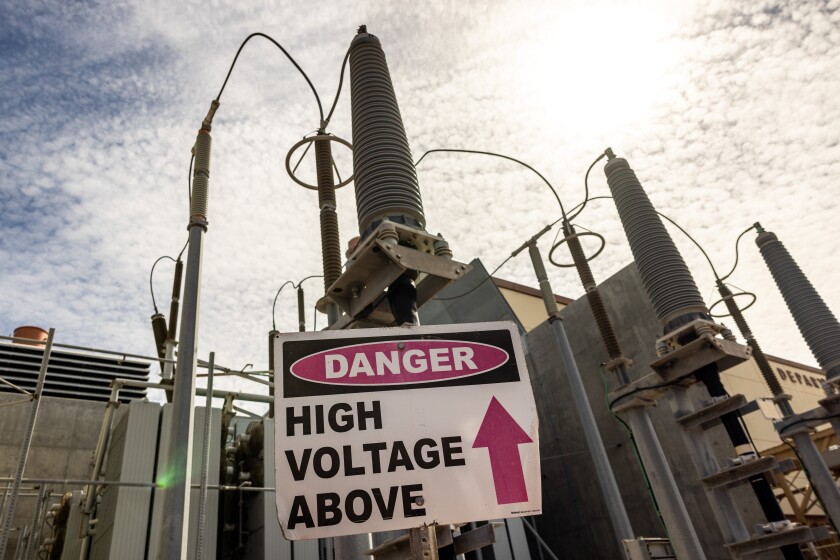
A sign warns of high-voltage wires at DWP’s Scattergood Generating Station near El Segundo.
(Jay L. Clendenin / Los Angeles Times)
As if to underscore that point, just last month SoCalGas was slapped with a $10-million state fine for fighting climate action.
But SoCalGas seems to realize some course correction is needed if it wants to secure political buy-in for its hydrogen plans. After years of fighting local gas bans, for instance, the company recently began suggesting it’s open to widespread adoption of electric heating and cooking. It didn’t appeal the $10-million fine. And it didn’t oppose ending subsidies for gas line extensions to new homes.
The utility also says Angeles Link could be part of “a comprehensive approach to facilitate the ultimate closure” of Aliso Canyon. That’s a possibility SoCalGas had never previously shown a willingness to consider as it defended the lucrative storage field.
“Southern California Gas is an infrastructure company. And we use that infrastructure to be able to meet customers’ needs,” said Brown, the company’s president. “Customers’ needs are changing. We see our customers needing cleaner and cleaner fuels.”
For all the latest Business News Click Here
For the latest news and updates, follow us on Google News.
